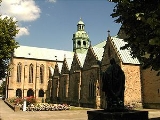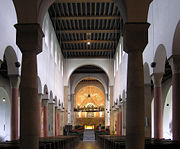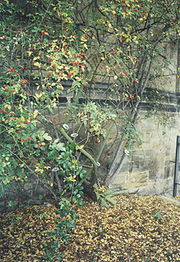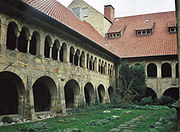
St. Mary's Cathedral, Hildesheim
Encyclopedia

Hildesheim
Hildesheim is a city in Lower Saxony, Germany. It is located in the district of Hildesheim, about 30 km southeast of Hanover on the banks of the Innerste river, which is a small tributary of the Leine river...
, Germany, is an important medieval Catholic cathedral
Cathedral
A cathedral is a Christian church that contains the seat of a bishop...
, that has been on the UNESCO World Cultural Heritage list since 1985.
The cathedral church was built between 1010 and 1020 in Romanesque style. It follows a symmetrical plan with two apses, that is characteristic of Ottonic Romanesque architecture
Ottonian Renaissance
The Ottonian Renaissance was a limited "renaissance" of economy and art in central and southern Europe that accompanied the reigns of the first three emperors of the Saxon Dynasty, all named Otto: Otto I , Otto II , and Otto III , and which in large part depended upon their patronage.One of three ...
in Old Saxony
Duchy of Saxony
The medieval Duchy of Saxony was a late Early Middle Ages "Carolingian stem duchy" covering the greater part of Northern Germany. It covered the area of the modern German states of Bremen, Hamburg, Lower Saxony, North Rhine-Westphalia, and Saxony-Anhalt and most of Schleswig-Holstein...
. After renovations and extensions in the 11th, 12th and 14th centuries, the cathedral was completely destroyed during an air raid on 22 March 1945
Bombing of Hildesheim in World War II
The German city of Hildesheim, ca. 30 kilometres south of Hanover was target of several Allied air raids in 1945.-Hildesheim during World War II:In 1939, Hildesheim had about 72,000 inhabitants...
, and rebuilt from 1950 to 1960.
The cathedral is famous for its many works of art. These include:
- The bronze doors, commissioned by Bishop Bernward (1015), with reliefs from the history of Adam and of Jesus Christ.
- A bronze column 15 feet high (dating from 1020), adorned with reliefs from the life of Christ.
- Two large wheel-shaped candelabra of the 11th century.
- The sarcophagus of St Godehard.
- St. Epiphanius’ Shrine (12th century).
- A Baptismal Font, dating from 1225.
In the middle of the cathedral's courtyard stands the Gothic
Gothic architecture
Gothic architecture is a style of architecture that flourished during the high and late medieval period. It evolved from Romanesque architecture and was succeeded by Renaissance architecture....
Anne's chapel (Annenkapelle), erected in 1321, which remained nearly undamaged during World War II. Also, climbing the wall of the cathedral's apse is the legendary 1000-year-old rosebush, which symbolizes the prosperity of the city of Hildesheim. According to the legend, as long as the bush flourishes, Hildesheim will not decline. In 1945 allied bombers destroyed the cathedral, yet the bush survived. Its roots remained unscathed beneath the rubble, and soon the bush was growing strong again.
The Cathedral Museum owns one of the most extensive collections of medieval treasures in Europe.
In 2010, a renovation was started which will be finished in 2014. In May 2011, the foundation of the first cathedral building dating from 815 was found under the floor of the crypt. The first cathedral building was a small church measuring 6 x 6 m with an apse
Apse
In architecture, the apse is a semicircular recess covered with a hemispherical vault or semi-dome...
in the east. The remains of the first altar were found in the apse. A grave was discovered under the foundation, possibly the first bishop of Hildesheim was buried here. The foundation of the first cathedral building consists of sandstone and it is extraordinarily thick.





External links
- More information about St. Mary's Cathedral (Hornemann Institut)
- Pictures (Raymond Faure's Website)
- Homepage of the Cathedral Museum (in German)

